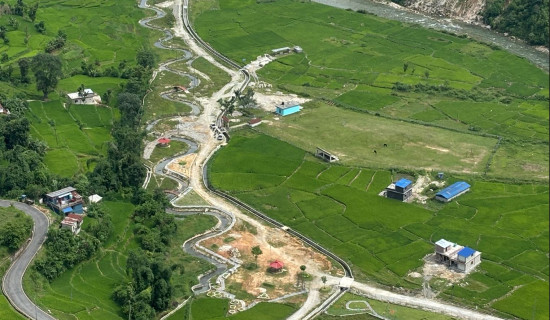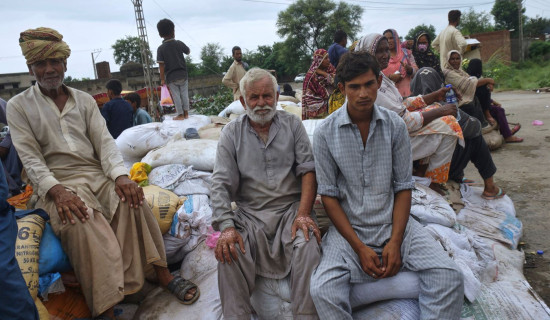- Tuesday, 2 September 2025
Rare black panther terrifies Bagbire locals
BY KOKILA DHAKAL,Ilam, Sep. 2: A rare black leopard was recorded for the first time in Ilam on Monday, sending shockwaves through the rural community of Bagbire in Suryodaya Municipality-2 after it killed three goats and was later found resting inside a local shed.
The unprecedented attack, believed to be the first confirmed instance not just in Ilam, but in all of Koshi Province, has sparked fear among residents already grappling with a rise in wild animal attacks.
The incident unfolded early on Monday morning when Tanka Kafle, a local, discovered that three of his goats had been attacked to death. When villagers entered his shed around 10 am to feed the animals, they were stunned to find the black leopard still inside, its belly visibly full, lying quietly in a corner.
“The leopard was not aggressive at that moment, it looked exhausted and content,” said Raju Ghimire, Chairman of the Laligurans Community Development Committee. “Its deep black coat immediately caught our attention. We knew it was something rare, so we informed the police and the local administration without delay.”
According to Ghimire, two adult goats and one kid were killed in the attack. But this was not an isolated event. “This month alone, leopards have killed seven goats in our area,” he said. “Fear is spreading fast. People are now afraid to send their children to school or even go out to gather firewood.”
Other nearby residents have also reported livestock losses. Sher Bahadur Gurung of Maijogmai Rural Municipality-2, Harka Singh Rai of Mul Kharka, and Gopal Khadka of Bijje have all lost goats in similar nighttime raids. Over a dozen goats have been killed in the past few weeks alone.
While animal attacks are not new in the hills of Ilam, the appearance of a black leopard, also known as a melanistic leopard, is unprecedented. Ward No. 2 Chairman Dika Bamjan said that the leopard might have crossed over from India’s Singhalila National Park, which shares a border with Nepal.
“This is the first documented case of a black leopard in Koshi Province,” said Birendra Sah, Chief of the Ilam Division Forest Office. “The last known sighting in Nepal was in Kavre district, years ago. A special rescue team has been deployed from Koshi Tappu Wildlife Reserve to safely remove the animal and begin further investigation.”
Due to a lack of trained wildlife rescue personnel in the district, the leopard remained inside the shed for hours, guarded by locals and officials who had covered the area with red cloth to keep the animal calm until help arrived.
Local leaders are calling attention to what they describe as a long-standing failure by the government to equip rural districts with proper wildlife management systems.
“We’ve been fighting a losing battle for years,” said Ghimire. “Wild boars have destroyed maize and potato crops, monkeys ravage fruit trees, and now leopards are killing livestock. Last year, some villagers tried installing electric fences, but they were dangerous for people and had to be removed.”
In the meantime, northeastern Ilam continues to suffer from unchecked wild animal intrusions. While no human casualties have been reported so far, the economic toll and psychological strain on residents are growing.
The Area Police Office in Nayabazar admitted that no accurate records exist of animal-related losses, further complicating compensation efforts and policy planning.
As the villagers of Bagbire await the safe removal of the rare predator, the incident has reignited debate about the balance between conservation and community safety, especially in regions where human and wildlife habitats are increasingly overlapping.















